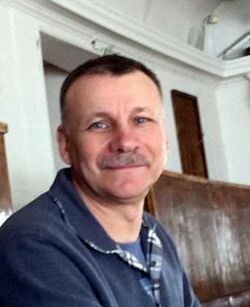Biography:Gennadiy Borisov
Gennadiy Borisov | |||||||||||
|---|---|---|---|---|---|---|---|---|---|---|---|
 | |||||||||||
| Born | Gennadiy Vladimirovich Borisov[1] 1962 (age 62–63)[2] Kramatorsk[2] | ||||||||||
| Occupation |
| ||||||||||
| Employer | Sternberg Astronomical Institute | ||||||||||
| Known for | Discovery of 2I/Borisov | ||||||||||
| Spouse(s) | Nadezhda Borisova[citation needed] | ||||||||||
| Awards | Edgar Wilson Award (two awards in 2014) | ||||||||||
| MARGO observatory | |||||||||||
| Observatory code | L51 | ||||||||||
| Location | Nauchnyy, Bakhchysarai Raion, Crimea | ||||||||||
| Coordinates | [ ⚑ ] 44°43′35″N 34°0′45″E / 44.72639°N 34.0125°E | ||||||||||
| Altitude | 574 m (1,883 ft) | ||||||||||
| Established | 2013[3] | ||||||||||
| Telescopes | |||||||||||
| |||||||||||
| Designation | Type |
|---|---|
| C/2013 N4 (Borisov) | long-period |
| C/2013 V2 (Borisov) | hyperbolic |
| C/2014 R1 (Borisov) | near-parabolic |
| C/2014 Q3 (Borisov) | Halley-type |
| C/2015 D4 (Borisov) | long-period |
| C/2016 R3 (Borisov) | long-period |
| C/2017 E1 (Borisov) | hyperbolic |
| 2I/Borisov | hyperbolic, interstellar |
| C/2019 V1 (Borisov) | near-parabolic |
| C/2020 Q1 (Borisov) | long-period |
| C/2021 L3 (Borisov) | hyperbolic |
Gennadiy Vladimirovich Borisov (Russian: Генна́дий Влади́мирович Бори́сов; born in 1962 in Kramatorsk)[2] is a Crimean [5] telescope maker and amateur astronomer who discovered the first-known interstellar comet, 2I/Borisov, in 2019.
Work
Borisov works as an engineer at the Crimean Astronomical Station (ru)[Note 1] of the Sternberg Astronomical Institute of Moscow State University.[6][7] There, he maintains the telescopes, but does not make observations himself. He also works with Astronomicheskiy Nauchnyy Tsentr JSC, creating experimental telescopes in collaboration with Roscosmos.[8]
Borisov pursues astronomy in his spare time at his personal observatory MARGO located in Nauchnyi, in the southern part of the Crimean peninsula. Between 2013 and 2019, he discovered nine comets[4] and several near-Earth objects such as 2013 TV135.[6] These discoveries were made using telescopes he designed and built himself: GENON (2 comets), GENON Max (5 comets)[8][1] and the unnamed 0.65 m telescope (2 comets, including 2I/Borisov). In 2014, Borisov received two Edgar Wilson Awards for his discoveries of C/2013 N4 and C/2013 V2.[9] Borisov also discovered the asteroid 2023 BU, another near-Earth object that passed within 4,000 km of the Earth in January 2023.
Discovery of 2I/Borisov
In early 2019, Borisov completed his new 0.65-meter telescope.[10][6] On August 30, 2019, he used this telescope to discover the first known interstellar comet, 2I/Borisov, which is only the second interstellar object to have been observed.[6][11]
Borisov described his discovery thus:[12]
| “ | I observed it on August 29, but it was August 30 GMT. I saw a moving object in the frame, it moved in a direction that was slightly different from that of main asteroids.[Note 2] I measured its coordinates and consulted the Minor Planet Center database. Turned out, it was a new object. Then I measured the near-Earth object rating,[Note 3] it is calculated from various parameters, and it turned out to be 100% – in other words, dangerous. In such cases I must immediately post the parameters to the world webpage for confirmation of dangerous asteroids.[Note 4] I posted it and wrote that the object was diffuse and that it was not an asteroid, but a comet. | ” |
The discovery of 2I/Borisov by Gennadiy Borisov has been compared to the discovery of Pluto by Clyde Tombaugh.[8] Tombaugh was also an amateur astronomer who was building his own telescopes, although he discovered Pluto using Lowell Observatory's astrograph.
Discovery of 2023 BU
On January 21, 2023, Borisov discovered the relatively small asteroid 2023 BU, only 5 days before it would pass an initially calculated 9,975 ± 27 km (6,198 ± 17 mi)[citation needed] from the centerpoint of Earth, closer than geostationary satellites but further than low Earth orbit satellites.
Views
Borisov thinks that soon amateur astronomers will no longer be able to discover new comets: "In 2016, only I discovered a comet. In 2013, there were seven of us. Every year there are less and less. There are more and more huge telescopes. Amateurs will soon have nothing left."[8]
Notes
- ↑ Not to be confused with the Crimean Astrophysical Observatory, which is located right next to it.
- ↑ Of the 800,000 objects known to orbit the Sun, 737,000 (92%) of them are main-belt asteroids.
- ↑ NEO Rating for calculating the probability that a new object is a near-Earth candidate.
- ↑ The NEO Confirmation Page for confirming near-Earth objects and potentially hazardous objects.
References
- ↑ 1.0 1.1 1.2 1.3
"Error: no
|title=specified when using {{Cite web}}" (in Russian). https://www.ancprotek.ru/pg_2_6.html. - ↑ 2.0 2.1 2.2
Смирнов, Дмитрий. "Error: no
|title=specified when using {{Cite web}}" (in Russian). https://crimeanblog.blogspot.com/2014/09/borisov.html. - ↑ Template:Cite tech report
- ↑ 4.0 4.1 "JPL Small-Body Database Browser — Search string: Borisov". https://ssd.jpl.nasa.gov/sbdb.cgi?sstr=Borisov.
- ↑ Overbye, Dennis (7 December 2019). "The Interstellar Comet Has Arrived in Time for the Holidays". The New York Times. https://www.nytimes.com/2019/12/07/science/interstellar-comet-2i-borisov.html.
- ↑ 6.0 6.1 6.2 6.3 King, Bob (11 September 2019). "Another Interstellar Visitor Is Headed Our Way". https://www.skyandtelescope.com/astronomy-news/possible-interstellar-comet-headed-our-way/.
- ↑
"Error: no
|title=specified when using {{Cite web}}" (in Russian). http://www.sai.msu.ru/dept/crimea/index.html. - ↑ 8.0 8.1 8.2 8.3
Нелюбин, Николай (13 September 2019). "Error: no
|title=specified when using {{Cite web}}" (in Russian). https://www.fontanka.ru/2019/09/13/052/. - ↑ "The Edgar Wilson Award Recipients". http://www.cbat.eps.harvard.edu/special/EdgarWilson1.html.
- ↑
"Error: no
|title=specified when using {{Cite web}}" (in Russian). 12 September 2019. https://www.gazeta.ru/science/news/2019/09/12/n_13455625.shtml. - ↑ Agle, DC; Johnson, Alana (12 September 2019). "Newly Discovered Comet Is Likely Interstellar Visitor". https://www.nasa.gov/feature/jpl/newly-discovered-comet-is-likely-interstellar-visitor.
- ↑ (in Russian). 16 September 2019. para. 5. https://ria.ru/20190916/1558728005.html.
External links
- A video interview with Borisov (in Russian, but subtitles can be enabled with auto-translation into English)
 |

